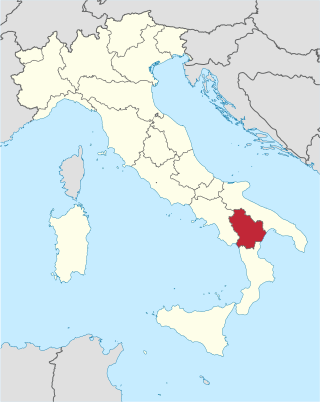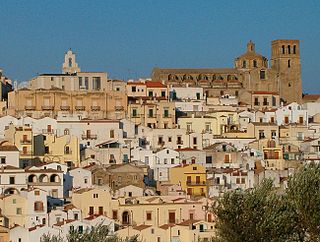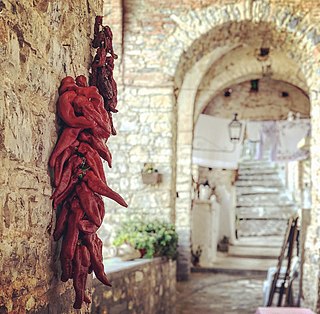
Matera is a city and the capital of the Province of Matera in the region of Basilicata, in Southern Italy. With a history of continuous occupation dating back to the Palaeolithic, it is renowned for its rock-cut urban core, whose twin cliffside zones are known collectively as the Sassi.

Basilicata, also known by its ancient name Lucania, is an administrative region in Southern Italy, bordering on Campania to the west, Apulia to the north and east, and Calabria to the south. It has two coastlines: a 30-km stretch on the Tyrrhenian Sea between Campania and Calabria, and a longer coastline along the Gulf of Taranto between Calabria and Apulia. The region can be thought of as the "instep" of the "boot" of Italy, with Calabria functioning as the "toe" and Apulia the "heel".

Melfi is a town and comune in the Vulture area of the province of Potenza, in the Southern Italian region of Basilicata. Geographically, it is midway between Naples and Bari. In 2015 it had a population of 17,768.

Castelmezzano is a town and comune in the province of Potenza, in the Southern Italian region of Basilicata. It is bounded by the comuni of Albano di Lucania, Anzi, Laurenzana, Pietrapertosa, Trivigno.

Ferrandina is a town and comune in the province of Matera, in the Southern Italian region of Basilicata. It is a center for production of high quality olive oil.

Garaguso is a town and comune in the province of Matera, in the Southern Italian region of Basilicata.

Oliveto Lucano is a town and comune in the province of Matera, in the Southern Italian region of Basilicata. Its mayor is Nicola Terranova. This town is most known for the "Maggio Festival", which is dedicated to St. Cyprian and takes place on 10, 11 and 12 August.
Salandra is a town and comune in the province of Matera, in the Southern Italian region of Basilicata.

San Mauro Forte is a town and comune in the province of Matera, in the Southern Italian region of Basilicata.

Cirigliano is a town and comune in the province of Matera, in the Southern Italian region of Basilicata.
Stigliano is a town and comune in the province of Matera, in the Basilicata region of southern Italy.

Brienza is a town and comune in the province of Potenza, in the Southern Italian region of Basilicata.
Santeramo in Colle is a town in the Metropolitan City of Bari and region of Apulia, southern Italy.

The Archdiocese of Matera-Irsina is a Latin archdiocese of the Catholic Church in Basilicata, Italy. It has existed under this name since 1986. The archbishop is seated at Matera Cathedral.. It is a suffragan of the Archdiocese of Potenza-Muro Lucano-Marsico Nuovo.
The Cavone is a river in the Basilicata region of southern Italy. It is 49 kilometres (30 mi) long, and has a drainage basin of 675 square kilometres (261 sq mi). Its source is west of Accettura in the province of Matera near the border with the province of Potenza. The river flows northeast near Oliveto Lucano and Garaguso before curving southeast. It flows near Salandra and San Mauro Forte before being joined by a right tributary. The river is joined by a left tributary north of Craco. It flows southeast near Pisticci and empties into the Gulf of Taranto.
The Church of San Leonardo, Italian: Chiesa di San Leonardo, is a cave church in the rione of Sasso Caveoso of Matera, in Basilicata in southern Italy. It takes its name from a fresco of San Leonardo. The church is deconsecrated, and was until recently used as a bakery. The date of foundation of the church is unknown; it was first documented in 1543–44, when it was without a door and repairs were ordered.

The Carnival of Satriano, held in Satriano di Lucania, Italy every February, is one of the country's many carnivals. Held on the Friday, Saturday and Sunday before Fat Tuesday, it has been conducted for centuries. The event is among the most important carnival traditions of the region and of Italy and it is unique in that participants wear costumes, or masks, of bears, hermits, or lent.

The cuisine of Basilicata, or Lucanian cuisine, is the cuisine of the Basilicata region of Italy. It is mainly based on the use of pork and sheep meat, legumes, cereals and vegetables, with the addition of aromas such as hot peppers, powdered raw peppers and horseradish. The local gastronomy is, for historical-cultural reasons, typically peasant, based on simple recipes and on the culture of reuse, in particular of meat and bread.

The convent of Santa Maria del Gesù vulgo di Sant'Antonio, more simply called the convent of Sant'Antonio. It is a Christian religious complex of Catholic rite, with an adjoining homologous church, currently home to a community of minor friars (Franciscans), initially entitled to Santa Maria del Gesù and then to Sant'Antonio da Padova. It falls within the archdiocese of Acerenza.

Festival of St. Julian, also known under its Italian names Maggio di Accettura and Maggio di San Giuliano, or in short "Maggio", is an annual festival celebrated around Pentecost by the people of Accettura, a village in Basilicata, Italy.





















